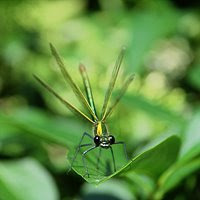It not easy to find such sites, even when they are big, but maybe I do not use the right search terms. Here is a list of sites which I know of. If you know more, please let me know (for example add a comment).
Personally I make use of a Dutch site at http://waarneming.nl. The code of this site is used in Belgium at http://waarnemingen.be, and even in a worldwide variant at http://observado.org. These sites are not only meant for dragonflies, but for basically all groups of organisms. It is most active for bird sightings.
 The generated maps in the worldwide variant includes the sightings from the Dutch and Belgian variants. The worldwide variant seems to be in use mainly by people from the Netherlands and Belgium, recording their sightings when on holiday. For odonata it generates maps like this (for Aeshna mixta). As you can see it makes use of Google Maps. See for the actual map on the site here. Evidently most sightings come from the Dutch and the Belgian database.
The generated maps in the worldwide variant includes the sightings from the Dutch and Belgian variants. The worldwide variant seems to be in use mainly by people from the Netherlands and Belgium, recording their sightings when on holiday. For odonata it generates maps like this (for Aeshna mixta). As you can see it makes use of Google Maps. See for the actual map on the site here. Evidently most sightings come from the Dutch and the Belgian database.There is another Dutch site at http://www.telmee.nl. I am not sure how much these sites are in competition. What I read is that they do exchange entered sightings (if the observer agrees), but that the exchange process could be better.
All sites above are offered in different languages.
In Denmark there is http://www.fugleognatur.dk. My Danish isn't very good, and I do not see an option to change the language. To get to the dragonfly section, click the link Naturbasen and then in the dropdown with the text "Vælg artsgruppe", pick "Guldsmede" (which is the Danish word for dragonflies). That gives the recent sightings. The odonata species list is at Artslister -> Guldsmede. Each species has some information, including a map of the sightings.
In Germany I am aware of two sites: http://www.naturgucker.de (which does all organisms - including odonata - and has some European-wide pretentions) and there is a dragonfly mapping project at www.science4you.org, called Libellen Europas.
For Sweden there is a dragonfly mapping project at artportalen.se, with an odonata species list + map.
Then for North-America there is http://www.odonatacentral.org. Well, actually also this has world-wide pretentions, but the searching on the map for Aeshna mixta, currently shows just 2 records, both in the UK. But it seems that there are many records for North-American species.
I guess I should end with some conclusion or recommendation, but I have none. It is nice to see that things are working more or less. And of course one can dream of about a world-wide united database. But user-entered data also need to be checked. And nobody is going to check user-entered sightings on a world-wide scale. On a smaller scale, there are experts who know what to expect, which data are impossible or improbable. For that reason, a small-scale (national) approach seems necessary to me. And if the checked sightings in the different databases can be exchanged between national initiatives, that would be great.

1 comment:
Hi,
For some months now you can find also a website dedicated to Romanian dragonfly here: http://dragonfly.nature4stock.com/
For now there are only photos and distribution maps... but will grow... sorry is in Romanian but you can easy hit the flag you want for a google translation.
will be nice to hear any observation or critics,
cosmln
Post a Comment